How is the calculation of sewage: technical points in an
The calculation of the sewage system allows you to prevent frequent blockages of domestic sewage, system repairs, overflow of wastewater and other unpleasant situations. The easiest way to calculate the system according to the norms of SNiP, so as not to delve into complex mathematical formulas.
In this article we will examine in detail how sewage calculations are performed for a number of parameters.
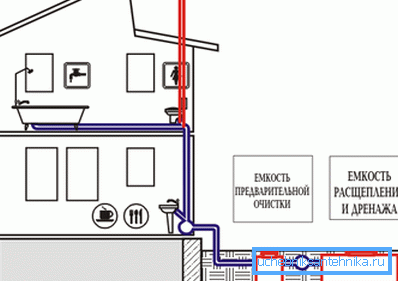
Types of sewer calculations
The term “sewer network calculation” usually includes:
- Calculation of sewage slope to the septic tank, cesspool or central sewer;
- Distances of sewage elements to significant objects (refers to the external system);
- Hydraulic calculation;
- Determining the amount of materials.
Next, take a closer look at all these points.

Tilt angle
Internal systems
The angle of the pipeline is necessary to ensure the flow rate of about 70 centimeters per second. This is the so-called self-cleaning speed, at which there is less likelihood that the system will get clogged.
There are quite a few methods for determining the minimum angle of slope of a sewer pipe. However, it does not make sense to carry out new calculations, since the results are known in advance.
The main thing you need to know that the angle depends on the diameter of the pipes:
- If the pipe diameter is 40-50 mm, the slope must be at least 3 cm per meter.
- If the diameter is 85-100 mm, the slope must be at least 2 cm per meter.
It must be said that many home masters are sure that the greater the slope, the better the sewage system will function. However, this opinion is not true.
The maximum slope should be no more than 15 cm per meter. The fact is that the drains that pass through the pipeline are heterogeneous. With a large slope, separation of the suspension into liquid and solid substances occurs, resulting in solid substance deposited on the walls of the pipeline.
Exceptions are areas with a length of up to one and a half meters, which are adjacent directly to the plumbing fixtures. The angle of inclination may be unlimited.
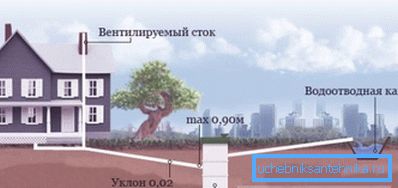
Outdoor systems
When installing external sewer pipelines, you must comply with the following requirements:
- For pipes with an internal diameter of 150 mm, the slope must be at least 0.8 cm per meter;
- For pipes with a diameter of 200 mm - not less than 0.7 cm per meter.

Storm sewer
It must be said that the calculation of storm sewage often requires determination of the angle of inclination not only for the pipeline, but also for drainage ditches. Their minimum slope depends on the diameter and type of ditch cover, however, it is not less than 3%, but ditches with a slope of 5-7% are most often performed. As for the pipeline, the minimum slope should be the same as for the above external sewers.
Distance to significant objects
Determination of the distance of the external sewage system is carried out taking into account the fact that the system should not violate the environment even in case of an accident. Therefore, according to the existing standards established by SES and SNiP, the minimum distance to significant objects should be as follows:
| An object | Distance |
| Distance from cesspool or septic tank to a residential building | 5 m |
| Pond | 30 m |
| Well or wells | 20 m |
| Of trees | 3m |
| Site boundaries and roads | 20 m |
| Creek or river | 20 m |
Compliance with these rules is monitored by employees of sanitary and epidemiological stations and local authorities. For their failure relies a penalty with the obligatory transfer of sewage.
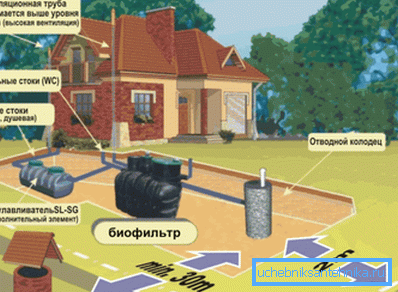
Note! The depth of the septic tank is not regulated, so you should focus on the pipe, which approaches the body under a certain bias. As for the depth of freezing, it does not matter, since inside the structure the positive temperature always remains as a result of the decomposition of organic matter.
Hydraulic
Hydraulic calculation of sewer networks requires the definition of the following unknowns:
- The diameter of the pipeline;
- The degree of fullness of the system (h / d).
It should be noted that the definition of slope also applies to hydraulic calculations, however, as already mentioned above, the known values given above are usually used.
Degree of fullness
Work household sewage network in a private house or apartment provides an incomplete filling of pipes. In essence, this is a certain reserve of system capacity, which is necessary to ensure ventilation in the system, the possibility of skipping all kinds of large items, etc.
Depending on the diameter of the pipeline, the following optimal filling values are established:
| Diameter | Maximum occupancy |
| 150-250 mm | 0.6 |
| 300-400 mm | 0.7 |
| 450-900 mm | 0.75 |
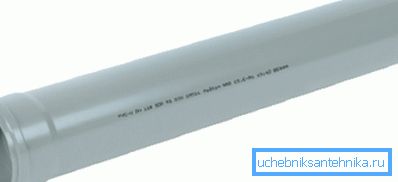
Pipe diameters
To perform mathematical calculations of the required diameter of pipes also does not make sense, since there are generally accepted optimal values:
| Purpose | Diameter |
| To drain the toilet | 100-110 mm |
| Pipes for removal of drains from the bathroom and kitchen | 50 mm |
| Riser | 110 mm |
Note! When installing the sewer network, if possible, the pipeline should be as uniform as possible. It is necessary to avoid any level differences. The flow rate should be constant, which will ensure the best operational properties of the system.
Thus, the tables for the hydraulic calculation of sewer networks allow even inexperienced masters to correctly carry out their project, according to which the installation of the pipeline.
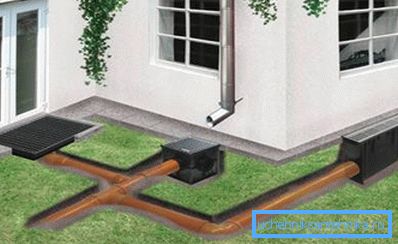
Storm system
With the hydraulic calculation of the stormwater system, the situation is somewhat more complicated, since in this case it is necessary to use the formula - V = q20xSxD, where:
- V - the highest rate of water consumption during drainage.
- S is the surface area.
- q20 - the greatest intensity of precipitation. This indicator can be found in the SNiP reference book (depends on the location).
- D is the coefficient of moisture absorption by the base material.
The coefficient of moisture absorption can be found in the following table:
| Material | Absorption coefficient D |
| Crushed stone with bitumen | 0.6 |
| Rubble | 0.4 |
| Cement concrete | 0.85 |
| Asphalt concrete | 0.95 |
| Roof | one |
Now consider an example of the calculation of storm sewers. Suppose there is a plot of 1500 m2, of which 300 m2 are covered with flower beds and lawns. Accordingly, the lawns will absorb precipitation, so it is necessary to determine how much water will be supplied to 1200 m2.
For example, the highest intensity of precipitation is 25 liters per square meter per hour.
In this case, the calculation is performed as follows:
- On a plot of 1200 square meters per hour, a maximum of 30,000 l or 30 m3 of rain falls. This is the amount of water that must be diverted.
- Now it is necessary to determine the diameter of the pipe that will cope with this amount of precipitation.. A pipe with a diameter of 110 mm, laid with slopes of 1 cm per meter, is capable of carrying 6.19 liters per second, which is 2220 liters per hour. In our case, this is too small, so the best option would be a pipe with a diameter of 160 mm.
- From the above table it follows that such a pipe can be laid with a slope of at least 0.8 cm per meter.
For a more accurate calculation, you can multiply the volume of incoming water by the coefficient of moisture absorption, however, so that the carrying capacity has a small margin, you can not do this. After completing the calculations, you should proceed with the installation of the system itself.

Counting materials
After all the technical aspects of sewage are calculated, you can find out how many pipes and other materials will be needed for its installation. It will also let you know what the price of the project is.
It is very simple to perform such a calculation - it is necessary to draw a plan of a house or a plot to scale, and then apply all the elements of the sewage system to it. After that, it will not be difficult to calculate the total length of the pipeline. Here, perhaps, the whole instruction on the calculation of sewage.
Conclusion
Calculate household sewage under the force of every home master. To do this, use the data from the above tables and technical references. The result of these calculations will be reliable and durable operation of the sewer system. From the video in this article, you can get more information on this topic.